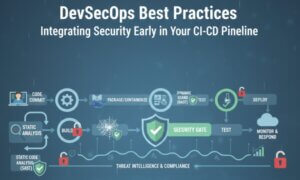API vulnerabilities continue to be a major concern for organizations of all sizes. Among the most dangerous threats facing modern APIs is Broken Object Level Authorization (BOLA). Often ranked at the top of the OWASP API Security Top 10, BOLA remains a common yet often misunderstood flaw. But what is BOLA, and how does it affect API security?
In this blog, we’ll break down BOLA in detail, demonstrate how it can be exploited, and provide best practices to prevent it. If you’re responsible for building or securing APIs, understanding BOLA is essential to protecting user data and maintaining trust.
Book your FREE security consultation today!
What is BOLA?
BOLA (Broken Object Level Authorization) is a security vulnerability that occurs when an API fails to properly validate whether a user has access to a specific object or resource. In simple terms, it means that an API allows users to access data they shouldn’t be allowed to see or modify.
Real-World Analogy
Imagine you’re in a hotel with keycards. Each guest has a keycard that only opens their own room. If the system had a BOLA flaw, any guest could use their keycard to open someone else’s room—just by entering a different room number.
In the context of an API, BOLA happens when a user manipulates the request to access a resource belonging to another user and the system doesn’t check if they are authorized to do so.
How Does BOLA Affect API Security?
BOLA can lead to severe security breaches because APIs are often the primary way applications communicate and handle sensitive user data. Here’s how BOLA impacts API security:
1. Unauthorized Access to Sensitive Data
Attackers can exploit BOLA to access personal or confidential information belonging to other users—like user profiles, financial records, or healthcare data.
2. Data Tampering and Manipulation
In some cases, BOLA allows attackers to modify or delete data that they shouldn’t have access to, leading to data integrity issues.
3. Regulatory Compliance Violations
APIs that fail to enforce proper authorization can put organizations at risk of violating regulations such as GDPR, HIPAA, or CCPA, which mandate strict controls over personal data.
4. Reputation Damage and Legal Risks
If an exploit becomes public or leads to a data breach, it can result in loss of customer trust, brand damage, and potential lawsuits.
How BOLA Works: A Technical Example
Consider the following API endpoint:
GET /api/v1/users/12345/orders
This request is supposed to return the order history of the user with ID 12345. A malicious user might change the ID to 12346 to try and view another user’s orders:
GET /api/v1/users/12346/orders
If the backend system doesn’t check whether the requester is authorized to access user 12346‘s data, it results in a BOLA vulnerability.
Why Authentication is Not Enough
Even if the user is authenticated (i.e., logged in), they can still perform unauthorized actions if the API doesn’t perform authorization checks at the object level.
BOLA vs Other Authorization Flaws
While BOLA is related to other access control issues, it is unique because it targets individual object access. Here’s how it compares:
| Vulnerability | Description |
|---|---|
| BOLA | No check if user is allowed to access specific resource (e.g., another user’s order) |
| BFLA (Broken Function Level Authorization) | No check if user can perform a certain action (e.g., DELETE operation) |
| Insecure Direct Object References (IDOR) | Similar to BOLA but focuses more broadly on exposing internal implementation details |
Why BOLA is So Common
1. Lack of Authorization Logic
Many developers assume that if a user is authenticated, they’re authorized to access everything under their account. Without explicit checks, this assumption leads to BOLA.
2. Rapid Development & Microservices
In agile environments, microservices and APIs are developed quickly, often without centralized security checks. BOLA can slip through the cracks.
3. Complex Business Logic
APIs may support complex relationships (e.g., nested user roles or permissions). If the logic isn’t properly coded or tested, BOLA can emerge.
Best Practices to Prevent BOLA
Now that we understand what BOLA is and how it affects API security, here’s how to prevent it:
1. Implement Object-Level Authorization Checks
Always verify that the authenticated user has permission to access or modify a specific object:
if order.user_id != current_user.id:
return 403 Forbidden
2. Use Centralized Authorization Logic
Create a centralized access control module to enforce consistent authorization rules across all endpoints and services.
3. Adopt Role-Based or Attribute-Based Access Control (RBAC/ABAC)
These models ensure fine-grained access to resources based on user roles or attributes.
4. Log and Monitor API Access
Log every request, especially those involving object access, and monitor for anomalies.
5. Use API Gateways and Middleware
API gateways can perform pre-validation and rate limiting, helping detect and block abnormal object access patterns.
6. Run Regular Security Tests
Conduct automated scans and manual penetration testing to identify BOLA vulnerabilities during development and in production.
7. Educate Developers
Train engineering teams to recognize and defend against BOLA and other API security risks. Security awareness is critical.
BOLA and Modern API Architectures
1. REST APIs
In RESTful services, endpoints are URL-based and often include object identifiers. These identifiers are easy to manipulate, making BOLA a frequent issue.
2. GraphQL APIs
GraphQL allows clients to define the structure of the data they want. While powerful, this also increases the risk of BOLA if object-level access isn’t validated in resolver functions.
3. Mobile and IoT APIs
Since these APIs often operate under bandwidth or resource constraints, developers might cut corners on security, leaving them vulnerable to BOLA.
Conclusion
So, what is BOLA? It’s a critical and common API vulnerability where inadequate authorization checks allow users to access unauthorized data. Understanding how BOLA affects API security is vital in today’s API-driven world.
BOLA can lead to massive data breaches, compliance issues, and loss of user trust. However, with the right strategies—such as object-level authorization, centralized security logic, and continuous monitoring—organizations can effectively protect their APIs.
If you’re developing or managing APIs, make BOLA prevention a core part of your security strategy.
Need help identifying BOLA vulnerabilities in your API? Contact the security experts at SecureMyOrg to schedule a full API penetration test and keep your application secure in 2025 and beyond.
Why Businesses Trust SecureMyOrg for Comprehensive Network Security
At SecureMyOrg, we uncover and fix all possible security vulnerabilities of mobile and web, while providing solutions to mitigate risks. We are trusted by renowned companies like Yahoo, Gojek and Rippling, and with 100% client satisfaction, you’re in safe hands!







Some of the things people reach out to us for –
- Building their cybersecurity program from scratch – setting up cloud security using cost-effective tools, SIEM for alert monitoring, building policies for the company
- Vulnerability Assessment and Penetration Testing ( VAPT ) – We have certified professionals, with certifications like OSCP, CREST – CPSA & CRT, CKA and CKS
- DevSecOps consulting
- Red Teaming activity
- Regular security audits, before product release
- Full time security engineers.
Relevant Posts

How To Inspect Encrypted Traffic Without Breaking Privacy
Network administrators face a challenge: securing systems while respecting privacy. This guide explains how to inspect encrypted traffic without breaking privacy using metadata, anomaly detection, and machine learning ensuring visibility, compliance, and trust.

How to Audit Infrastructure as Code (IaC) for Security Vulnerabilities
Discover how to audit Infrastructure as Code (IaC) for security vulnerabilities with this practical guide. Learn to scan IaC files using tools like Checkov, fix issues like exposed resources, and integrate audits into CI/CD pipelines. Protect your cloud systems from misconfigurations and ensure compliance with clear, actionable steps.

DevSecOps Best Practices: Integrating Security Early in Your CI/CD Pipeline
This article provides a practical guide to embedding security into every stage of your CI/CD pipeline. Learn core DevSecOps best practices like SAST, DAST, dependency scanning, secrets management, and compliance automation to catch vulnerabilities early, foster a culture of shared ownership, and build a secure-by-design development process that accelerates release cycles.

5 Cloud Misconfigurations That Lead to Data Breaches
Cloud misconfigurations are one of the leading causes of data breaches, yet they’re also among the most preventable. From exposed storage buckets to weak IAM policies, attackers exploit these mistakes daily. Learn about the top 5 misconfigurations and how your organization can fix them before they lead to costly data exposure.

How Can Ethical Hacking Training Elevate Your Internal Cybersecurity?
Ethical hacking training empowers organizations to strengthen internal cybersecurity by uncovering vulnerabilities before attackers do. From mastering penetration testing to enhancing incident response, this training builds a proactive security culture. Learn how Secure My ORG’s programs can elevate your team’s skills and fortify defenses against modern threats like AI-driven attacks.

AI‑Generated Malware: Threat or Hype?
AI-generated malware uses advanced algorithms to create adaptive and hard-to-detect threats, posing serious challenges for modern cybersecurity defenses. Unlike traditional malware, it can evolve on its own, learning how to bypass security systems without human input. As a result, cybersecurity teams must increasingly rely on AI-driven tools and strategies to detect and neutralize these sophisticated digital attacks.


